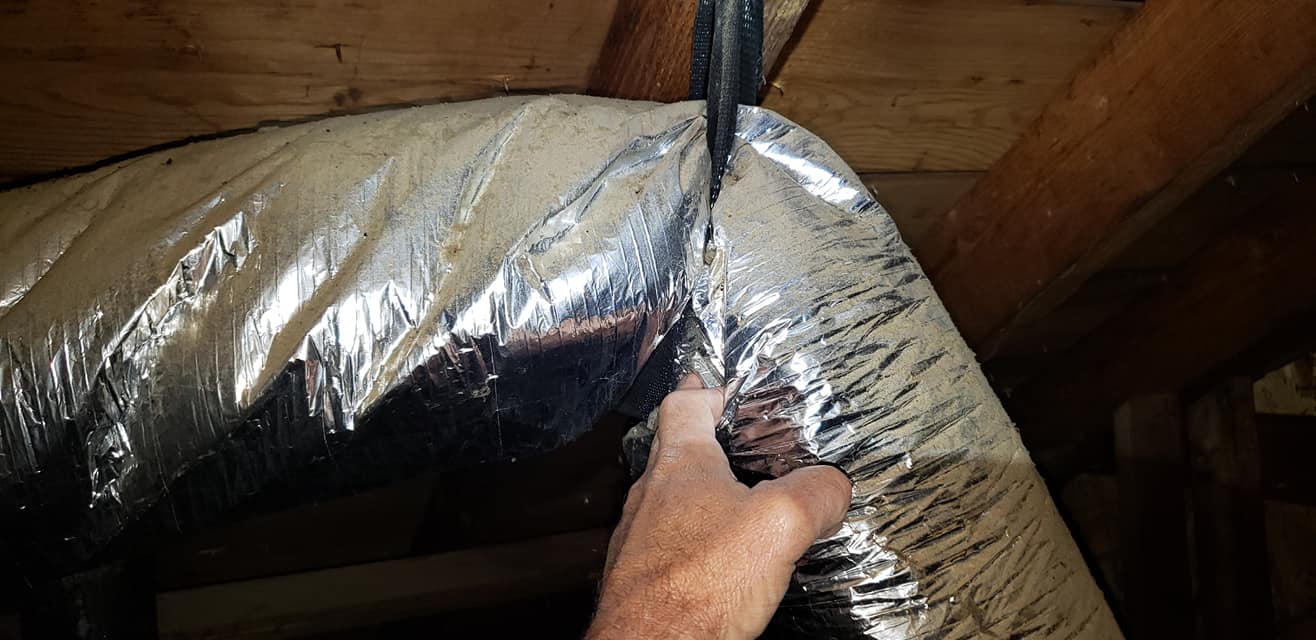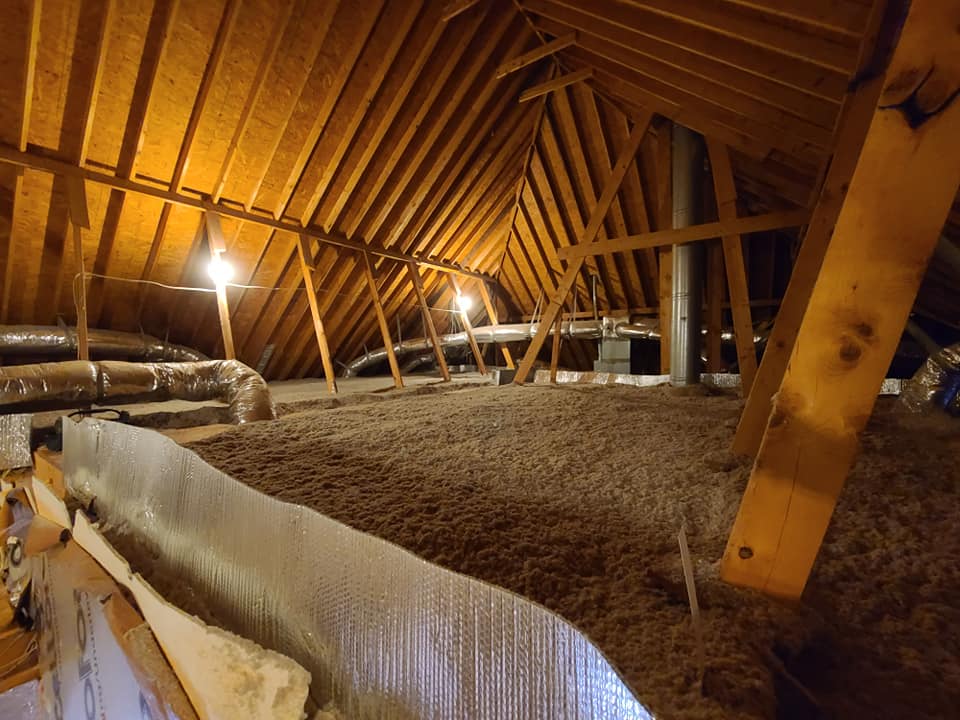Why aren’t our air ducts better insulated?
May I pose a few questions for consideration, and make a few comparisons?
Alison Bailes, over at Energy Vanguard first got me thinking in this direction, with his excellent blog article on a similar subject.
You see, I’ve been hard at work serving Atlanta homeowners for over twenty years (I re-insulated my first attic in 1998), and in 2004 I am convinced that it was God who gave me the revelation to focus on improving air ducts, while standing in a 140 degree Alpharetta attic.
Here at Bird Family Insulation, about HALF (50%) of our jobs include some type of air duct improvement.
Honestly, I can’t make this stuff up! The air ducts in our attics and crawlspaces are in terrible shape! Every day I see ducts that are:
- Squeezed like an hourglass, with tight straps.
- Pinched and twisted around framing, and filled with U-turns.
- Crushed and mashed.
- Torn, ripped, or chewed.
- Infiltrated with moisture.
- Barely held together with tape.
- Leaking airflow at connections.
- Spliced, connected, spliced and more spliced.
- Strapped high against a roof that is over 140 degrees hot.
- Sized TOO SMALL, especially the return air ducts.

Plagued With Bad Duct Systems
And I am always seeing (probably 75% of the time) systems that need more Return Air flow. In fact, yesterday, at my 3rd appointment, my homeowner has a 3-ton AC system in his attic, dedicated to the upstairs living space. That area is roughly 1250 ft2 living space.
There was one, 14” central return vent in the upstairs foyer. We know that this equipment is designed to move 400 cfm per ton of AC. So, shouldn’t the ducts connected to this 3 ton equipment be sized to allow for 1200 cfm? Yet, there is one lonely 14” flex duct for the Return air. When I look up airflow for a 14” flex duct, I find that the maximum airflow is 650 cfm! (I keep these tables and charts in my phone for easy & quick reference to show my homeowners).
I asked Mr Homeowner, “Which rooms up here are the most difficult to keep comfortable?”
By the way, this simple question has added so much money to our bottom line, simply because few if any insulation contractors are having these conversations with homeowners in my city!
After a brief show-and-tell conversation, with both of us in the attic, he had convinced himself that he needed more than a few more inches of attic insulation.
We’re installing a dedicated Return air vent in each of three bedrooms, along with bumping up the attic insulation to R-40 with our all-borate cellulose.

Budgets vs Air Duct Improvements
There was so much more that could be done with those ducts! I get it… we’re all living on a budget, and it’s challenging to spend a few thousand dollars to completely re-duct your house when you ‘re not budgeting for it.
Two weeks ago, I had a similar conversation with Mr & Ms homeowner with a large family of small children. All the bedrooms are upstairs, and they wanted more attic insulation, because… “we can’t keep living like this. Two of those rooms are roasting hot, while the boys room over the garage is freezing from too much cold air”.
My first question when I returned from the attic was simple: “Is this your forever home? Is this the house where you want to raise your children?” The answer was a strong YES!
They’re air ducts were designed around a system of distribution boxes and excessively long duct runs with small-diameter ducts… all attached to a huge 4 ton machine.
My counsel to them was very clear: We’re going to redesign & balance the entire air duct system upstairs, and AFTER THAT, I’ll upgrade your attic insulation. Phase 1, and Phase 2.
Throughout every Atlanta summer, I measure the surface temps of air ducts suspended in these attics. It’s typical to see numbers like 119 degrees, 128 degrees, while the attic roof deck temps are 130 degrees and 140 degrees.
And we wonder why we aren’t getting cold air from our vents.
When I measure air temps coming from the ceiling vents, I often see temperatures in the mid 60 degree range. In fact, last week I measured the temperature of the air coming from the supply air vent in a master bedroom bath. It was 64 degrees.
Can you imagine how long it takes to cool a room to 74 degrees, when you’re using airflow that is only 10 degrees cooler? This isn’t rocket science!

Show Me Cold Air!
If we open up your machine in the attic, while the AC is running – and test the air temp, you would discover that the temps are in the mid 40 degree range.
By the way, I made a video of this: https://www.youtube.com/watch?v=BACgM5VnNps
So, what happened to 20 degrees of my cold air? How are you losing 20 degrees between your machine and the ceiling vent in your bedroom, bonus room, or master bath?
That machine and the system of air ducts is only, AT BEST, (if a recent system) insulated to R-8. If your air ducts are 10 years old or more, they are insulated to R-6 or less.
Now follow me with my logic, regarding insulation and R Values …
Currently built attics are required to have R-38, and kneewalls have R-19.
Currently built floors are required to have R-19.
Currently built walls are required to have R-13.
But the air ducts in that same attic are only insulated to R-8.
This article would be too long if I compared the “Delta T” numbers of each of those ratings in real life.

Let me just whet your curiosity…
The AC temperature at the machine is 45 degrees. The attic is 130 degrees. That gives us a Delta T of 85 degrees.
If it’s a gas furnace, the air temperature in the heat cycle will be approximately 120 degrees, and the attic temperature might be 40 degrees on a cold January midnight. The Delta T is 80 degrees.
So, 80 degrees Delta T is about average for our Air duct systems in cooling and heating seasons. And our air ducts are insulated with R-6 or R-8 insulation.
Remember, Delta T is the contrast (change or difference) in temperature. So, that R-8 insulation is assigned the “Protection Detail” to keep the air temp SAFE from the 80 degree difference in temperature from inside to outside of those fragile ducts.
I’m not purposely being wordy… I’m trying to answer her question, “Bob, what happened to my 20 degrees of cold air?”
Let’s assume you like to keep your home at 74 degrees in summer, and 70 degrees in winter.
Our average high summer temperature is 89 degrees. We know the average high temp in your vented attic will be 130 degrees. Winter attic temperatures may average lows of 40 degrees and highs of 70 & 80 degrees or more.
Here are the Delta T numbers for our sample ceiling.
Ceiling Delta T: Summer is 56 degrees, and winter is 34 degrees.
And you are required to have a minimum of R-38 attic insulation, and the U.S. Department of Energy recommends R-49 for your attic.
Here’s the BIG PROBLEM
The highest Delta T # for our sample attic is in the summer, which is 56 degrees.
Yet, the Delta T for the air ducts in our example is 80 degrees.
Science and common sense teach us that the farther apart the temperatures (Delta T), the more insulation you need.
How do you dress for winter outdoor activities? Bundled-up, right?
But it’s ok to insulate your air ducts with a weak, anemic R-6 or R-8 “protection detail”, and it’s no wonder our heating and cooling systems can’t keep up, and our bills are higher than necessary.
My homeowner’s question has a simple answer: “Your air ducts are being overwhelmed with the heat in your attic, and that 20 degrees difference in “lost cold air” is due to the heat being absorbed.”
I’ll close with some 8th grade science: HOT always moves to COLD. It’s a law. It’s called the 2nd law of Thermodynamics.
Those inferno-like summer temps in your attic are IRRESISTIBLY drawn to your cold air ducts. Like ants to a piece of chocolate cake!
And with a Delta T of 80, protected with only R-6 or R-8 duct insulation, your cold temperatures are not protected as well as they should be. It’s a war you are losing each time your HVAC cycles!
With a duct system located in a vented attic, your quickest remedy is to dramatically improve the R Value of those air ducts. There are several ways to accomplish this… and the quickest, and a most excellent solution, is to spray the air duct system with a protective coating of low-pressure Closed Cell spray foam insulation. And you’ll get your ducts sealed and save that ~ 30% of duct leakage!
It’s our Instant Shade Tree service. Learn more here: https://birdinsulation.com/our-services/air-duct-services/air-duct-insulation/
Need an instant estimate for insulation or air duct services? Use our EZ Online Calculators at HERE!
Thanks for reading!
Bob Bird





